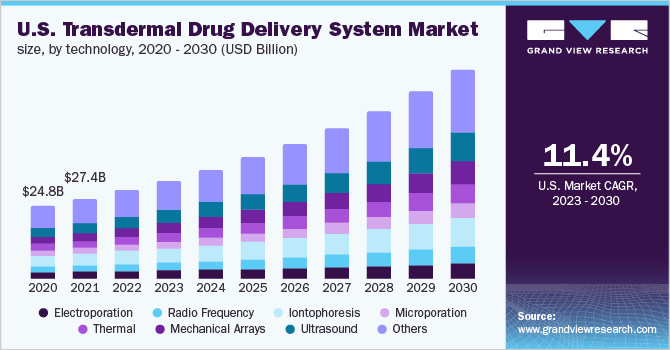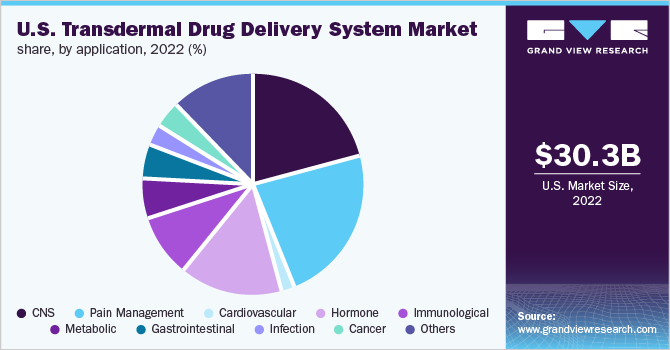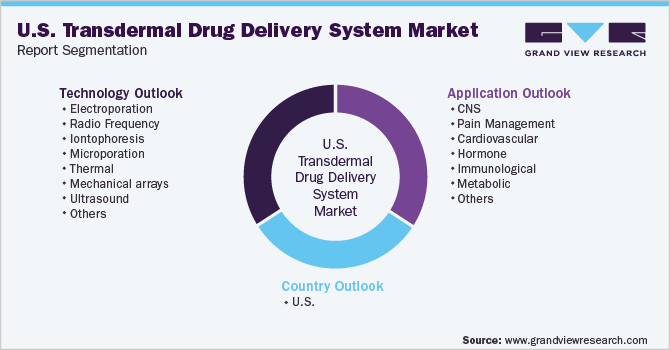- Home
- »
- Medical Devices
- »
-
U.S. Transdermal Drug Delivery System Market Report, 2030GVR Report cover
![U.S. Transdermal Drug Delivery System Market Size, Share & Trends Report]()
U.S. Transdermal Drug Delivery System Market (2023 - 2030) Size, Share & Trends Analysis Report By Technology (Iontophoresis, Mechanical Arrays), By Application (Pain Management, Cardiovascular), By Country, And Segment Forecasts
- Report ID: GVR-4-68038-103-0
- Number of Report Pages: 120
- Format: PDF
- Historical Range: 2018 - 2021
- Forecast Period: 2023 - 2030
- Industry: Healthcare
- Report Summary
- Table of Contents
- Segmentation
- Methodology
- Download FREE Sample
-
Download Sample Report
Report Overview
The U.S. transdermal drug delivery system market size was valued at USD 30.31 billion in 2022 and is expected to expand at a compound annual growth rate (CAGR) of 11.4% from 2023 to 2030. Increasing demand for painless drug delivery, coupled with rising demand for self-administration of drugs, is anticipated to fuel the growth. The growth of the market is also propelled by ongoing technological advancements in the field.

The COVID-19 pandemic ushered in mask mandates, quarantines, product shortages, business closures, and businesses scrambling to figure out new ways to keep their doors open. The pandemic had a huge negative impact on the U.S., with the country reporting the highest number of COVID-19 cases for a majority of the time over the two years of the pandemic. Therefore, the U.S. transdermal drug delivery system market observed a significant drop in sales as well. Reduced number of patients visiting healthcare facilities and a large number of people opting to quarantine themselves as a precautionary measure resulted in a drop in sales.
However, the pandemic highlighted many loopholes in the healthcare system and the country is now working toward them to avoid such circumstances in the future. Moreover, with everything returning to normalcy and the U.S. government now, more than ever, focusing on the healthcare sector, the market is expected to flourish at a rapid pace.
The transdermal drug delivery system represents the most attractive method among various recently emerged non-invasive administrations as an alternative to conventional needle injections. This is because of its excellent ease of administration, low rejection rate, excellent convenience, and persistence among patients. It can be applicable in pharmaceuticals as well as the skin care industry, including cosmetics. This makes it an ideal option for the non-invasive administration of drugs and in turn, drives the demand for these systems.
The high prevalence of chronic disorders is anticipated to fuel the market for transdermal drug delivery systems. Cardiovascular disorders, Alzheimer’s disease, and diabetes are some of the leading chronic conditions affecting U.S. citizens. These conditions require round-the-clock monitoring and frequent dose administration, thus facilitating the market growth. For instance, according to the American Diabetes Association, about 37.2 million people in the U.S. had diabetes in 2019.
Transdermal drug delivery systems represent a great potential to administer insulin non-invasively. Microneedles used for transdermal delivery can improve patient compliance and patients can self-administer it. Therefore, it signifies great potential as an alternative to traditional insulin therapy. Thus, increasing preference for therapies that can be self-administered is also a major factor boosting the demand for transdermal drug delivery systems.
Technology Insights
The iontophoresis segment dominated the market in 2022 owing to technological advancements. Moreover, this technology has many advantages such as avoidance of first-pass metabolism for systemic administration, as well as faster administration and better control of the delivered dose in comparison to the usual passive transdermal formulations.
The mechanical arrays segment is anticipated to progress at a lucrative CAGR of over 12.7% throughout the forecast period. An increasing number of product launches by prominent industry players and increasing adoption of micro-needling in aesthetics exemplify the high growth potential possessed by this segment. For instance, in June 2021, Eclipse received FDA approval for its latest medical-grade micro-needling device, the MicroPen EVO. The product was launched in Canada last year and has been available to dermatologists and aesthetic practitioners in the U.S. since June 2021.
Application Insights
The pain management segment held the highest share of 22.7% in 2022. This is due to the increasing prevalence of chronic diseases and trauma. The growing prevalence of musculoskeletal disorders such as arthritis, osteoarthritis, and orthopedic degenerative disorders is also contributing to a rise in the prevalence of chronic pain. According to Osteoarthritis Action Alliance, in 2022, an estimated 32.5 million people are affected by osteoarthritis in the U.S.
The CNS segment held the second largest share owing to the growing burden of neurological disorders such as Alzheimer’s. According to the Alzheimer’s Association, an estimated 6.5 million people aged 65 and over are living with Alzheimer’s in the U.S. as of 2022. This is further projected to grow up to 12.7 million by the end of 2050.

The cardiovascular segment is anticipated to undergo maximum growth over the forecast period. Increasing utilization of transdermal drug delivery systems in the treatment of hypertension, congestive heart failures, and angina pectoris is majorly driving the growth of the cardiovascular segment. For instance, the advent of nitroglycerin, clonidine, and isosorbide dinitrate transdermal systems, used in the treatment of hypertension, have proven to be highly efficacious in treating complicated as well as uncomplicated treatment phases.
Key Companies & Market Share Insights
Mergers and acquisitions form one of the key sustainable strategies undertaken by market players. For instance, in June 2022, Novartis AG acquired Kedalion therapeutics, a U.S.-based company, to strengthen its drug delivery business. Through this acquisition, the company aims to enhance the delivery and patient experience with its medicines.
In addition, Nutriband Inc. completed the acquisition of Pocono Coated Product's Transdermal and Health product manufacturing business. The company aims to expand its business and advance its in-house manufacturing capabilities to become a leading player in the transdermal drug delivery system market. Some prominent players in the U.S. transdermal drug delivery system market include:
-
Novartis AG
-
Johnson & Johnson
-
Viatris Inc.
-
Boehringer Ingelheim GmbH
-
Biogel Technology, Inc.
-
3M Company
-
Noven Pharmaceuticals, Inc.
-
Nutriband Inc.
-
Transdermal Corporation
-
Echo Therapeutics, Inc.
U.S. Transdermal Drug Delivery System Market Report Scope
Report Attribute
Details
Market size value in 2023
USD 33.60 billion
Revenue forecast in 2030
USD 71.63 billion
Growth rate
CAGR of 11.4% from 2023 to 2030
Base year for estimation
2022
Historical data
2018 - 2021
Forecast period
2023 - 2030
Quantitative units
Revenue in USD billion and CAGR from 2023 to 2030
Report coverage
Revenue forecast, company ranking, competitive landscape, growth factors, and trends
Segments covered
Technology, application, country
Country scope
U.S.
Key companies profiled
Novartis AG; Johnson & Johnson; Viatris Inc.; Boehringer Ingelheim GmbH; Biogel Technology, Inc.; 3M Company; Noven Pharmaceuticals, Inc.; 4P Therapeutics, LLC; Transdermal Corporation; Echo Therapeutics, Inc.
Customization scope
Free report customization (equivalent up to 8 analyst’s working days) with purchase. Addition or alteration to country, regional & segment scope
Pricing and purchase options
Avail customized purchase options to meet your exact research needs. Explore purchase options
U.S. Transdermal Drug Delivery System Market Segmentation
This report forecasts revenue growth at the country level and provides an analysis of the latest industry trends in each of the sub-segments from 2018 to 2030. For this study, Grand View Research has segmented the U.S. transdermal drug delivery system market report based on technology, application, and country:

-
Technology Outlook (Revenue, USD Billion, 2018 - 2030)
-
Electroporation
-
Radio Frequency
-
Iontophoresis
-
Microporation
-
Thermal
-
Mechanical arrays
-
Ultrasound
-
Others
-
-
Application Outlook (Revenue, USD Billion, 2018 - 2030)
-
CNS
-
Pain Management
-
Cardiovascular
-
Hormone
-
Immunological
-
Metabolic
-
Gastrointestinal
-
Infection
-
Cancer
-
Others
-
Urological
-
Blood disorders
-
Respiratory
-
Musculoskeletal
-
-
-
Country Outlook (Revenue, USD Billion, 2018 - 2030)
-
U.S.
-
Frequently Asked Questions About This Report
b. The U.S. transdermal drug delivery system market size was estimated at USD 30.31 billion in 2022 and is expected to reach USD 33.6 billion in 2023.
b. The U.S. transdermal drug delivery system market is expected to grow at a compound annual growth rate of 11.4% from 2023 to 2030 to reach USD 71.63 billion by 2030.
b. Pain management segment dominated the U.S. transdermal drug delivery system market with a share of 22.7% in 2022. This is attributable to growing prevalence of chronic diseases that is leading to rise in chronic pain.
b. Some key players operating in the U.S. transdermal drug delivery system market include Novartis AG; Johnson & Johnson; Boehringer Ingelheim GmbH; Viatris, Inc.; 3M Company; and Noven Pharmaceuticals, Inc..
b. Key factors that are driving the market growth include increasing demand for painless drug delivery and rising demand for self-administration of drugs
Share this report with your colleague or friend.
Need a Tailored Report?
Customize this report to your needs — add regions, segments, or data points, with 20% free customization.

ISO 9001:2015 & 27001:2022 Certified
We are GDPR and CCPA compliant! Your transaction & personal information is safe and secure. For more details, please read our privacy policy.
Trusted market insights - try a free sample
See how our reports are structured and why industry leaders rely on Grand View Research. Get a free sample or ask us to tailor this report to your needs.










